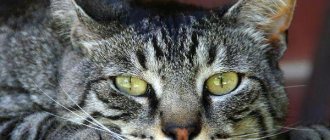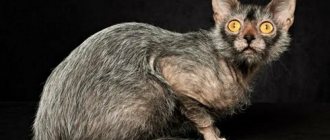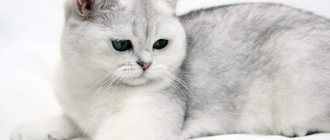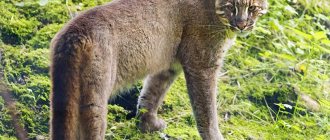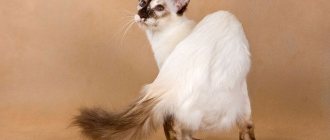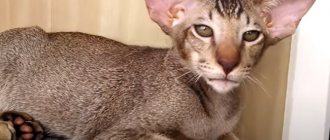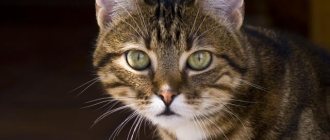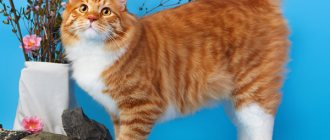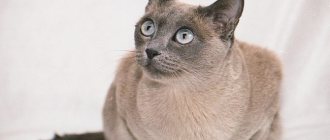Cats have long settled next to humans. People domesticated their wild ancestors in order to obtain help in the fight against rodents and to find docile, harmless companions. Over time, man learned to preserve the necessary qualities of character and color in his offspring. Gradually, new breeds of furry purrs arose. However, outbred cats did not disappear, but gradually filled the space of populated areas around the world. Regardless of their origin, cats remain devoted to their owners and give them their love every day. Today our material is dedicated to outbred furry pets.
History of the barn cat
The hypothesis of universal kinship is not an allegory at all. Geneticists conducted a study of 797 animals and found that they descend from at least 5 common ancestors on the maternal line. Among the test subjects were both purebred and barn cats. So a homely mongrel and a tribal aristocrat Persian are not so far from each other.
It has been scientifically proven that the founder of the genus was a wild steppe cat. It still lives in the space from the Far East to North Africa, confirming the powerful natural immunity and ability of the genus to survive. After this, is it any wonder why a yard cat adapts to any living conditions?
Archaeologists claim that next to humans, these animals appeared somewhere in the Fertile Crescent region (on the modern map, an arc from Turkey to Libya). At this time, people began to master agriculture, food supplies attracted rodents, and cats followed them. This is how the first wave of migration of these animals occurred and no one needs to be convinced that they were all outbreds.
After 2.5-3 thousand years, cats spread to North Africa and Europe. The active stage of domestication of these useful animals has begun. But until now, people have not completely tamed their wayward cats.
Trainer's determination
With kindness and love you can create miracles - you can teach even the most resistant to training at home.
But above all, your personal goal is what you want to teach your pet. Remember! Cats will never do anything they don't like - it's their innate character trait!
During the game, I observe the behavior of the furry student, notice what he likes to do, offer new tasks, new movements, and adapt to him. For each performance I praise, pet and offer a treat. I practice patiently every day before each feeding for 5–10 minutes, no more. The main thing is that the purr does not get tired and does not get tired of performing the same trick.
Important! Conduct classes in a positive and friendly manner. Never scold, never hurt, never deceive
Remember! Food, praise, and affection play an important role in a cat’s life.
Is there a street breed?
The division based on appearance happened much later:
- The history of breeds begins in 1000. Around this time, the first mentions of the Norwegian forest cat date back to this time. She is also considered the ancestor of the Siberian longhaired population.
- Later, Siamese, Abyssinians, Egyptian Mau, Persians and Turkish Angora were identified. Even the names clearly show the region from which they all migrated to Europe.
- 1758 Swedish naturalist Carl Linnaeus introduced the concept of Felis catus, a binomial name for the species.
- 17 years later (1775), his colleague from Germany von Schreber supplemented this section with the name Felis silvestris, identifying wild cats as a separate group.
- 1871 The first official cat show took place in London - 170 animals were shown in 25 categories.
From that moment on, the cat world was divided into purebred purebreds and simple street cats.
No one would dare to claim that outbred cats have any characteristic features. The point is not only in their diversity, but also in their amazing adaptability. Even formerly pampered pets quickly adapt to the street.
They have offspring with any homeless partner and thereby replenish the population of outbred animals.
There is a street breed of cats: they are counted not on the basis of size, build and color, but on the basis of the “cat’s soul.” Some of them value freedom much more than close communication with people.
Although some cats prefer to stay indoors, most cats love to go outside.
Home can be a quiet and boring place for them. There is fresh air outside, bugs, birds, sounds that excite and excite the cat. Cats that spend a significant amount of their time outdoors tend to require less grooming and cause fewer problems for you: they can go to the bathroom outside, there will be less cat hair in your house, and they may need less play time. when they return home after an eventful day. In addition, sometimes outdoor cats are more suitable for your lifestyle than their indoor counterparts who have already spent a hole in their favorite sofa.
Native cat breeds
Native cat breeds are those that were created by nature without human intervention. They appeared in the wild and in certain areas through natural selection, adapted to living in a specific climate. People were only required to notice and consolidate the breed characteristics.
Different countries around the world have their own native cat breeds. In Russia it is:
- Don Sphynx;
- Russian blue, Siberian and Altai blue-eyed cats;
- Ural rex;
- Kurilian bobtail.
Kurilian Bobtail
Names of foreign native cat breeds:
- Burmese;
- British;
- European Shorthair;
- Egyptian Mau;
- korat;
- Maine Coon;
- Norwegian forest;
- oriental;
- Persian;
- Singaporean;
- Thai;
- Turkish Angora and Van;
- Chartreuse.
General information
Fact: White cats do not always suffer from hearing loss; blue-eyed pets are more likely to suffer from it. Neither complete nor partial lack of hearing worsens the animal’s quality of life: a developed sense of smell and sensitivity to vibrations compensate for the impairment.
Names of popular breeds of white cats:
- Persian
- Angora cat (Turkish Angora)
- British Shorthair
- Balinese cat (Balinese)
- Maine Coon
- Khao Mani (Diamond Eye (from English - “diamond eye”))
- Russian white cat
- Cornish Rex
- Scottish lop-eared
- Exotic
Types of outbred cats
The non-standard genotype and different living conditions explain the wide variety of outbred cats. An outdoor cat can give birth to offspring with very different appearances; it is almost impossible to predict the appearance of kittens in advance. As a result of the mixing of many native and purebred cats, and, consequently, the hereditary characteristics they carry, the individuals that are born have a very diverse color and body structure. Yard cats can be classified by the length of their coat.
Outbred cats can be very different
Short-haired mongrel cats
Simple mongrel cats most often have short hair, the colors of which can be very different. The striped color, the so-called tabby, clearly prevails; it can be found in combination with white, red and black. Uniformly colored individuals are also common; they can be pure black, red, all shades of gray, and sometimes white.
Short-haired cats are considered the southern type because they prefer to live in regions with mild, warm climatic conditions . Their coat is quite sparse, thin and often completely devoid of undercoat. The overall tonality is often light. Such animals rarely reach a weight of more than 5 kg; they have a slender, lean and graceful body with rather long and thin legs. The head is slightly elongated, straight ears are set high and slightly rounded. The tail is usually long and mobile, but can also be short. Eye color is often yellow or green. Although there are also cats with a different iris color.
Southern cats most often have short hair and almost no undercoat.
Long-haired mongrel cats
The northern type of yard cats acquired longer hair with a good dense undercoat, as the climate obliges this. In harsh and cold climates, animals grow larger, their weight often reaching 6 kg. The physique is massive, stocky, the bones are strong and solid. The limbs are thick, slightly short, the paws are wide. The head is round with large eyes of greenish-yellowish tones. The ears are erect and medium in size. The tail is thickened, long or short. The color of long-haired northerners is predominantly darker.
We recommend reading: American Shorthair cat: description, photo, character
In cold climates, cats are more likely to have long, thick fur.
A purebred cat can look very different, it all depends on what blood is mixed in it and the genes of which ancestors (distant and not so distant) predominate in it.
Under our own fence, we picked up a dirty outbred kitten that had obviously been planted on us. After the hygienic measures were taken, it turned out to be completely white, without a single dark spot. After several days it turned out that he was deaf. The baby turned out to be a blue-eyed albino.
Photo gallery: mongrel cats
Mongrel cats can have very original colors. Mongrel cats can have both short and long hair. Often, mongrel cats are very cute and attractive. Outdoor mongrel cats are unpretentious; they do not need to sleep on soft bedding. Sometimes mongrel cats look like ancient Egyptians. When a cat gets scared, it arches arched backs Outbred cats are excellent rat catchers On the street, outbred cats have to drink water from puddles Outbred cats are excellent mothers Street cats also sometimes get sick and look bad Outbred cats are also couch potatoes and sleep a lot On the street, cats often fight At first, cats try to intimidate each other
Description
The appearance of outbred pets is very diverse. Only a small part of this category consists of cats with long hair. These are mainly animals from northern countries. They are also distinguished by strong bones and a dense, stocky build.
Cats living in warm climates usually have thinner coats and no undercoat, making them appear lighter and sleeker.
The color variations in domestic cats are enormous. The most common color is “wild” (tiger). Blue cats are not uncommon in Western countries. In addition to single-colored animals, there are many two- and three-colored animals.
By standard, all colors are divided into groups:
- Tabby.
- Plain.
- Tortoiseshell.
- Chinchilla.
- Color point.
Moreover, all of them can be combined with white.
Features of street cats
Yard cats have certain characteristics in appearance and character. Most of them are similar in length and thickness of fur, body size and proportions, disposition and temperament. In addition, living in harsh conditions left its mark on their health and life expectancy. As for color, in street cats it can be either the most common or rare.
Common and rare colors
The shades of fur of yard cats are so diverse that their purebred brothers may envy them. Four-legged vagabonds can be found in a variety of colors, but most of them have a spotted or striped coat (see photo). This is how nature intended it, because such protective colors allow its owners to disguise themselves in case of danger or waiting for a victim. The rarest coat color for outdoor cats is white. Meeting a snow-white beauty on the street is real luck.
Length and thickness of coat
Among yard four-legged inhabitants, owners of long hair are rarely found. Usually such animals are short-haired. Tailed mongrels, depending on the characteristics of the climate in which they were formed, are conventionally divided into 2 types: northern and southern. The mustachioed “northerners” have long, thick hair, while the “southerners” have short hair without a pronounced undercoat layer. It is impossible to meet a hairless barn cat. Even if a street kitten is born completely hairless, it is unlikely to live long in harsh conditions.
Body type and dimensions
Representatives of the northern type have a dense, massive body. Four-legged “southerners” have a more graceful, less heavy build. Most tailed mongrels are medium in size. As for their weight, it usually ranges from 3 to 6 kg. These are average parameters. On the street you can meet both larger and very small animals.
Character and temperament
Outdoor kittens and adult cats have an energetic temperament. This is not surprising, because they literally have to fight for a place in the sun, so they simply have no time to yawn. Characteristics of tailed street dwellers:
- Lack of aggression and resentment. Such animals are extremely careful in showing their emotions, so it is difficult to understand what they really feel.
- Wary attitude towards people, especially strangers. If you bring a kitten or an adult animal home from the street, at first the new four-legged family member will shy away from everyone. He will trust the inhabitants of the home only after he is convinced of their good feelings towards him and the absence of a desire to offend him.
- Independence and self-sufficiency. These qualities are dictated by the harsh conditions of existence.
- A reverent attitude towards any manifestation of affection. Four-legged mongrels are so unaccustomed to affection that once they enter the house, they accept it with great gratitude.
Habitat
Jungle cats love warm climates, which is why their favorite places of residence are Central Asia and the Caspian coast. They also live near the rivers of Africa (Nile), in Thailand, on the island of Sri Lanka, in Palestine, India, Indochina, in eastern Eurasia, and in the Caucasus. On the territory of the Russian Federation, in addition to the Caspian Sea, they can be found in Dagestan and in the lower reaches of the Volga River.
Cats hate open areas, so they go there in rare cases, without going far from their place of permanent deployment. Cats love bushes and reeds, where they feel most at ease and safe. Seals love to settle in coastal shrub and reed areas. Houses are not at all keen on building their homes, but prefer to settle in empty fox and badger holes. They do not live in them for a long time, constantly moving to new places for safety reasons. You can see cat tracks on the shore; jungle cats leave them on the shallows. They swim and dive beautifully, hunting both aquatic birds and fish.
If a cat lives in a mountainous area, then it does not like to climb higher than 800 - 1000 meters, preferring its bushy, often thorny wilds. The cat doesn’t particularly want to have contact with people, leading a secretive and cautious lifestyle. During winter cold and early spring, it can visit human villages, carrying out bandit raids, with the aim of stealing poultry, which it loves to feast on.
We can say that the jungle cat is an omnivore that feeds on almost everything that comes under its clawed paw. He is not averse to feasting on birds, catching them in flight; eggs from nests also form part of his diet. The cat also catches all kinds of rodents (field mice, gophers, martens), sitting by the mink for hours waiting for prey. The cat will not refuse all kinds of insects and even amphibians; it can eat frogs, lizards and snakes. A jungle cat can get itself a white hare, or even a small wild boar, if the opportunity arises. Hunts for birds that live on the water, catches fish. It is no coincidence that he dives and swims beautifully.
It’s worth focusing on how interestingly the cat catches fish. He slowly slaps his paw on the surface of the water, creating the impression of a floundering insect, luring fish
If it swims up, it immediately gets hooked by its sharp claws that are deftly released. To fish it out, the cat plunges its head directly into the water.
Among rural residents, the cat is known as a robber and thief who invades chicken coops, steals chickens and other poultry, and can even steal a small pig. True, the jungle cat does not do all this so often, because... prefers not to come close to human settlements. Basically, robberies occur in the cold winter and early spring, when it is difficult to obtain food.
Making a new friend
The undoubted advantage of outbred cats is that no costs are required to purchase them. Usually such pets are acquired through friends or through an advertisement. Often, stray kittens are picked up on the street. If an animal is taken from home and there is a choice, in order not to make a mistake with the character and health of the kitten, you need to take a closer look at the following signs:
- the kitten readily approaches you, tries to flirt and does not try to show aggressiveness;
- the kitten is distinguished by its external attractiveness, meekness, agility, playfulness, playfulness and does not look sad, dejected or apathetic;
- holds his head up normally and walks or runs with absolutely no limp;
- does not twitch his head, does not have a runny nose, cough, or other external painful signs;
- the kitten's skin looks clean and healthy, without irritation, dirt, scabs or flea excrement;
- the animal's coat is shiny and clean, without bald spots or tangles (matted);
- no liquid or other discharge from the eyes, nose and ears;
- the third eyelid (the so-called nictitating membrane) does not cover part of the eye;
- teeth look clean and free of tartar, there is no unpleasant odor from the mouth;
- The gums of a healthy kitten are pink and there are no signs of bleeding;
- the stomach feels quite strong and at the same time not bloated;
- the anus is clean, without remains of feces, there are no visible signs of diarrhea or worm segments (they, if present, come out of the anus and look like grains of rice).
We recommend reading: Features of baby-face Yorkshire terriers: differences from the usual
It is recommended to wean a kitten from its mother no earlier than 2.5–3 months. At this age, the baby will tolerate separation without consequences for the psyche. He is already accustomed to the tray and “adult” food.
Cats are considered social animals. Therefore, experienced felinologists recommend, if possible, purchasing two kittens at once. For the company. Especially if the owners have to be away from home for a long time.
The offspring of outbred cats can be of a wide variety of colors
Cleanliness is the key to cat health
Caring for the appearance of a mongrel pet will not cause much trouble. The coat should be combed 1-2 times a week with a stiff brush to remove dead hair. During molting - 2-3 times. To avoid ear mites, wipe your ears with a cloth moistened with hydrogen peroxide. Use special ear drops. Remove discharge from the eyes with a soft cloth. Train your kitten to use a scratching post. This will save you and your cat from the unpleasant procedure of trimming its claws. You need to bathe your pet as soon as it gets dirty. But not often. Cats take care of their fur coats themselves. Almost everyone, with rare exceptions, does not like water procedures.
A good toilet for your beloved cat
When choosing a toilet for a kitten, focus on an adult cat, so as not to buy a new one when it grows up. The pet must enter it entirely. The height of the sides is not lower than 6 cm. It is better to use clumping filler for the tray. It absorbs odor well and simplifies the cleaning process. If finances allow, then the best option would be a box (dry toilet) with replaceable cassettes.
Light and air
Outdoor cats need fresh air and sunlight. Ultraviolet light promotes the production of vitamin B. If your pet constantly lives in an apartment, surprise him - in good weather, take him for a walk in the nearest park or forest. Use a harness with a leash for this. Avoid asphalt. For delicate cat paws, soft soil or grass is better. Try to avoid crowded areas of cars, people and dog walking so as not to scare your pet.
Choosing a purebred pet
Getting a cat without documents is not difficult. You can take a suitable pet:
- at a homeless animal shelter;
- in the nursery (unscheduled mating or presence of defects in the animal);
- by advertisement in various media (print publications, Internet resources, etc.);
- at the market, near the metro, at a transport stop;
- in a pet store;
- from neighbors, friends, etc.
As a rule, outbred animals are given away free of charge or for a symbolic price (a box of chocolates, a chocolate bar, etc.). But sometimes for mixed-breed cats, visually similar to purebred pets, they can charge about 1,500–2,000 rubles.
When choosing a kitten, you need to consider the following points:
- Baby's activity and mobility. He should run to get acquainted with curiosity, and not cower in a corner in fear.
- Healthy appearance. There should be no discharge from the eyes, ears or nose. The anus is pink and clean.
- Condition of the oral cavity. The teeth are clean, without tartar deposits. Gums are shiny. Pink and don't bleed.
- Wool cover. The fur is shiny and even, without bald spots or tangles.
- The abdomen is firm but soft.
- No defects (third eyelid, extra fingers, tail creases, etc.).
Not without its drawbacks
If you pick up a mongrel kitten on the street, you risk bringing a sick animal into your home. Be sure to take him to the vet right away. A little street child may have lichen or fleas. It may be infected with an infection or worms. If a purebred parent took part in the birth of a kitten, then, in addition to distinctive features, the baby can inherit genetic diseases inherent in the breed.
Well-groomed fur is the key to success at the exhibition
Scars decorate a wild cat
Outbred cats can take part in exhibitions. Felinologists have identified them in a special class - “domestic cat”. There are special beauty contests for them. Any outbred pet can take part in them. An exhibition of outbred cats is an event no less serious than competitions of elite breeds. At outbred exhibitions, an animal with any external signs of “eliteness” or showing signs of aggression cannot win. The presence of such defects as a broken tail and extra toes is allowed. What is unacceptable for purebred cats. Even injuries and scars can decorate the appearance of a domestic cat.
Kitten from the street: precautions
If the kitten was simply picked up on the street, then it needs to be put in a box or bag and taken not home, but to the veterinary clinic. You can't wash it now. If there are too many fleas and they are clearly bothering the baby, then you can use drops on the withers or a spray. The veterinarian will examine the pet, conduct the necessary examinations (for ringworm, infectious diseases, etc.) and after weighing, advise how and how to clean it of parasites (worms, fleas).
A street kitten must be shown to a veterinarian, who will examine it and take the necessary tests.
Some clinics offer the opportunity to leave a stray animal for quarantine, which is at least two weeks. In this case, all necessary procedures will be carried out at the medical institution.
If there are other pets at home (dogs, cats, etc.), the foundling is kept in quarantine in a closed and isolated room (bathtub, pantry, balcony, etc.), excluding any contact between animals. If the kitten does not show any suspicious or alarming symptoms, it looks cheerful and healthy, then after two weeks it is released into the common space. Then, following the recommendations of the veterinarian, the necessary vaccination is carried out.
If the selected baby is emaciated and very thin, then you need to feed him extremely carefully. You should not give cow's milk; it is better to use special cat milk substitutes. If the poor thing can already eat solid food, then little by little wet food for kittens is given.
Very small kittens will have to be fed with special formulas
If the kitten has injuries (dog bites, paw dislocations, etc.), only a veterinarian can help. At the clinic, the bite sites will be treated and, if necessary, stitches will be placed, and the necessary medications (antibiotics) and wound treatment products will be prescribed. You will have to treat the wounds daily for several weeks, since bites usually take a long time to heal. A foundling that is limping and dragging its paw should be immediately shown to a veterinarian, who will correct the dislocation or perform the necessary surgical operation. Only after applying a fixing bandage can the pet be taken home for rehabilitation.
How to accustom a cat to an apartment?
If outbred kittens come into the house from the street, the first step is to quarantine them - isolate them from family members and other animals for 10-14 days. During this time, the babies receive vaccinations and treatments.
Tray training for outbred cats follows the standard scheme:
- selection of container and filler;
- installation in a place convenient for the animal;
- monitoring the kitten and directing it to the litter box at the right time;
- consolidation of the skill.
It has been noted that outbred cats have a developed sense of self-esteem and demonstrate it from a young age. Force and coercion can lead to the desire to do the opposite, contrary to the will of people. But this is still considered an exception - clean cats themselves do not want to live among sewage.
Character
There are no two domestic cats with exactly the same character. Some are very affectionate, sociable and playful, others are distrustful and withdrawn. But all domestic cats are significantly inferior to dogs in terms of attachment to their owner.
If a small kitten is able to quickly get used to a new home and get used to its inhabitants, then not every adult outbred animal can easily do this.
Some people immediately find a common language with new people, including children, while others may remain completely indifferent to their surroundings for a long time.
Properly raised domestic cats sometimes simply adore their owners, accompanying them everywhere around the apartment. They easily get used to walking on a leash, respond to their name, and even learn the simplest commands.
They are usually very peaceful creatures that get along well with other pets. They often establish very friendly relationships not only with their relatives, but also with dogs, and even with decorative rodents.
Their pronounced predatory instinct manifests itself only in hunting mice and birds.
All cats (including outbred cats) are unusually clean animals. However, they still require some care.
Those with long hair need to be brushed regularly to prevent tangles from forming. It is possible that the cat will have to be accustomed to this procedure, then this should be done gradually, combing the fur a little every day.
A cat that has returned from a long walk and has gone on a spree must be washed.
Despite the fact that cats are excellent swimmers, they do not like water, so they also need to be taught to bathe. Wash the animal with warm water and regular soap.
At the same time, under no circumstances should they lather the wool itself. You need to dilute the soap foam separately and only then use it for washing. Rinse thoroughly with water.
It is not difficult to train a cat to use the toilet if the owner has taken care of the bath in advance, filling it with sand or a special cat litter. As a rule, the animal understands from the first time what is required of it.
Should stray cats be taken home?
The world is not without kind people, and the ever-decreasing population of stray animals always needs human help. The number of outbred cats in homes is several times higher than the number of their well-bred counterparts.
Veterinary experts consider three motives for which people take outdoor cats into their homes:
- compassion and desire to reduce the number of suffering animals;
- You don’t have to pay for a street kitten;
- a variety of types of feline “mongrels”, among which there is always a type suitable for “adoption”.
It has been noted that representatives of the yard cat breed almost never end up on the street again. People take full responsibility for the life of a stray animal and treat it with the same care as they treat expensive elite breeds.
Most often we are talking about yard kittens - in adulthood, animals are much less likely to find a new home.
Choosing a purebred cat
The decision is best made after the consent of all family members. Attention is drawn to the following circumstances:
- Age. A young cat will more easily enter a new environment and adapt to it. She had not yet developed the habits of a wandering life, and her character had not hardened in the struggle for survival.
- Health. Ordinary street kittens traditionally have strong immunity and natural endurance. Unlike purebred cats that undergo inbreeding, they rarely have genetic mutations. A healthy kitten should be playful, easy to run and jump, with shiny, even fur, pink gums and clean mucous membranes.
Appearance also plays a role in the selection process. They look at her first of all - after all, the aesthetic desire to own a beautiful animal overshadows everything.
The task is greatly simplified when it comes to the children of a domestic mongrel cat. Here the parents are already known (at least one of them), the kitten is under supervision and warm, and the mother cat has adequate feeding and the opportunity to raise her offspring.
No matter how healthy and active a mongrel kitten may seem, it must be shown to a veterinarian. Neglected childhood illnesses can turn into big problems.
Video: choosing a kitten
Unusual habits
A furry pet has a lot of habits. Almost all of them are associated with the basic habits characteristic of a given species. However, some habits may be individual, which means that they manifest themselves only in certain individuals.
First, let's look at the basic habits that can be seen in virtually all cats:
Cats lie and sit anywhere
A very common occurrence. A cat can rest almost anywhere - on a sofa, bed, pillow, even in the middle of a doorway. Sometimes this is quite cute, but most often it irritates the owner. She leaves her fur on various things, where a person then rests, preventing him from passing (and doesn’t even try to move). This behavior has its own explanation:
The cat always sleeps where it is comfortable for her. A soft sofa or a cozy pillow is exactly what you need. So it will be difficult to break this habit.
It is important for the owner to arrange a quality home for his pet so that he does not want to leave it. Does he like the pillow? So, put the old pillow in the place where she should sleep - and everything will be fine; if a cat prevents you from passing and does not even try to get out of the way, it means that it does not really respect you as an owner
You made mistakes when raising your pet. It is imperative to show who is the leader in the house. There is no need to bypass and baby-talk - this will only aggravate the situation. Raise your voice and force the animal to move out of the way; it can also be a manifestation of a desire to receive more attention. Play with the animal regularly, and it will definitely reciprocate your feelings.
Understanding the habits of cats
They mark territory
This is perhaps the worst habit of mustachioed pets. You need to get used to the tray from childhood. A kitten will quickly understand what is required of it, but training an adult pet will be problematic.
It is important to understand that the wayward character of a cat can manifest itself here too. For example, she won’t like the filler - after that, forget that she will be here to fulfill her natural needs
You'll have to replace the filler - there's no getting around it. Since they are also touchy, they can take revenge on the owner by relieving themselves in a completely unexpected place.
If an animal shits in people's shoes, this means:
- in the shoes of the owners - with the help of such a mark, the pet shows that these people already have a cat, and there is no need for others here;
- in the shoes of guests - the animal does not like the smell of others, and it wants these people to get out of “his” house as quickly as possible.
This is perhaps the worst habit of mustachioed pets - marking territory
It is most difficult with cats (although cats do leave marks, especially during heat), since the need to mark territory is part of their instincts. If you cannot cope with this, you will have to think about castration. After this procedure, even the most aggressive and disobedient cat will become a sweet and kind creature.
Features of caring for outbred cats
There are no differences in the responsibilities for keeping outbred and purebred cats. Both the first and second require equal attention:
- The fur is combed out, especially in long-haired animals. A beautiful fur coat is considered a universal indicator of health and psychological state. If it loses its shine and the hairs do not lie flat, then the animal has problems.
- The mucous membranes of the eyes and nose must be kept clean. To do this, they are periodically processed and unsightly crusts are removed.
- The ears are carefully cleaned with a cotton swab or swab.
- If necessary, trim the claws.
- The teeth of the descendants of feline mongrels usually remain healthy for a long time, but from time to time they also need to look into their mouths.
We recommend reading: Smooth-haired dog breeds for apartments, medium-sized, small and large with photos and descriptions
The only relaxation in maintenance and care is the absence of the need to select an appropriate gentleman for a mongrel cat. Here the choice is so great that no one has any difficulties.
Exhibition
A purebred cat can take part in exhibitions. Such exhibitions show how beautiful and diverse such cats can be despite their lack of documents. These exhibitions have their own rules. At such exhibitions, the cat’s appearance and care are assessed. It is worth noting that caring for the fur of such a cat is very difficult. Since her coat has its own specifics, it is very difficult to choose a shampoo.
The outbred cat is a very sweet and affectionate animal. It will amuse and delight you when you are happy or sad. By bringing such a kitten from the street, you will do a good deed and make yourself and the child happy. There is not a person on earth who would regret having a cat. Many lonely older people get themselves such a pet to make it more fun and not feel lonely.
The article contains up-to-date information on various issues related to mongrel cats, kittens and cats, which will be interesting to read for any lover of these cute furry creatures.
The average lifespan of a cat at home is 11-15 years. As a rule, outbred specimens live longer than their purebred counterparts, sometimes living up to 30-35 years. It all depends on the cat’s genetics, its immunity, health and many other indicators.
Pedigree cats require more care and attention and can be susceptible to various diseases, unlike mongrel animals.
Owners say that a purebred cat is no worse in character than its purebred counterparts; it is more resilient, dexterous, and cunning.
In the end, it all depends on the individual abilities of the animal, it is not so important whether it is purebred or not
— Outbred cats take part in cat shows, winning prizes. - They are more resilient, dexterous, cunning. — There are short-haired and long-haired. — Cats cannot taste sweets.
- The cat's brain is similar to the human brain. They have areas similar to those of humans that are responsible for their emotions. — A cat’s sleep can be up to 20 hours a day. — The largest offspring from one cat is 400 kittens.
Short-haired and long-haired mongrel cats
Distinctive features of short-haired mongrel cats: The color can be any, mostly tabby, short hair, with a short, stocky body, rounded muzzle. The ears are short, often wedge-shaped with tufts of hair, green eyes, stocky paws, and a thick tail.
Distinctive features of long-haired mongrel cats: Any color, long hair, often thicker around the neck and on the breeches, with a dense and strong body, a wary expression is inherent in the muzzle. The ears are short, often wedge-shaped with tufts of hair, greenish eyes, woolly paws, and a bushy tail.
Outbred cats weight norm, pros and cons
The average weight of a mongrel cat is 3.5-5.5 kg. The advantages of outbred cats include: - Price. You can get it for free, or for a nominal fee. — Outbred cats are not spoiled in their diet, they can eat anything, and rarely have indigestion. — Outbred kittens are more hardy and viable (even the smallest ones).
The disadvantages include: - It is unknown who will grow out of the little homeless lump. — A kitten picked up on the street must be treated for many “street” cat diseases. — It’s difficult to raise kittens if the mother grew up on the street. — According to the rules of cat breeding, an outbred animal must be sterilized. - They do not have the necessary “status”.
Characteristics of a mongrel cat
Outbred cats are easy to keep. They have an easy-going character. They are well accustomed to hygiene, have a variety of coat colors, are hardy and resilient. The owners note the playfulness and sensitivity of the animals, persistent and strong immunity.
Health and life expectancy
Most four-legged street dwellers are in good health and free of any genetic diseases. This feature was formed over centuries in wild conditions and was passed on to modern domesticated outbred cats.
Strong immunity is the basis for the long life of tailed mongrels (which does not negate the need for their vaccination and treatment for parasites). On average they live about 10–12 years. Among them there are often true centenarians, living up to 16–17 years.
Domestic mongrel pets usually live much longer than their counterparts who were not lucky enough to find loving owners. This is influenced by a well-fed life, regular care and the opportunity to use veterinary help in case of illness. Street animals must search for food on their own and often die, unable to cope with disease and hunger, becoming a victim of a dog attack or freezing to death.
Owner reviews
Outbred cats are valued by many pet lovers, including for their kind attitude towards children and sometimes even for their ability to alleviate illness.
Outbred cats are loyal and wise pets
According to the author, a purebred cat is one of those pets that are either for profit or for the “soul.” And if the cat is also picked up from the street, we can generally talk about an attempt to save the cat population on a small scale. The answer to such a truly human attitude towards animals will be kindness on the part of the cat, a periodic desire to cuddle and purr on the lap.
Outbred cats have been the most popular purrs since the times of the ancient Egyptians, which is explained by the strong immunity and docile nature of these tailed “little brothers.” In addition, you can purchase such a fluffy miracle only by leaving the house or by calling an advertisement for the donation of an animal as a gift.
Feeding mongrel cats
Feeding a mongrel street dweller can be a bit of a hassle. There are fewer problems with babies, but if a cat has managed to live in freedom and is accustomed to picking up food from the ground, it is almost impossible to re-educate it.
- At an early age, babies are given diluted goat's milk or special infant formula. Outbred kittens separated from their mother prematurely have not yet learned to eat and will require additional attention.
- For adolescents, the diet is increased by boiled minced meat in a liquid consistency or age-appropriate industrial food.
- Closer to six months, meat, fish, dairy products, vegetables and fruits are introduced into the cat’s menu.
- It is necessary to provide feed yeast and vitamin and mineral supplements. No matter how strong the natural immunity of a purebred cat may be, its support is mandatory.
- There must be water next to the food. The animal's access to it is left free around the clock.
Choosing cookware is not a difficult task. Plastic bowls are convenient and inexpensive, but their porous structure traps microscopic food debris. Therefore, it is necessary to thoroughly wash surfaces to prevent the growth of bacteria.
Those with large mustaches are the most picky about dishes. If they cling to the sides of the bowl, the cat begins to experience discomfort.
Advantages and disadvantages
Despite the fact that yard cats do not have such exclusive characteristics as their purebred counterparts, they are nevertheless not without merit.
- Lasting immunity. Breeding breeds using selective breeding methods has greatly weakened the immune system of animals. This is why the life expectancy of street cats is many times higher than that of purebred pets. Yard cats have strong protective functions of the body and are able to resist many infections.
- Personality Such animals tend to be docile in nature. They become very attached to the owner who picked them up on the street.
- Reproduction. Since yard cats do not need a purebred partner, finding a mate for them to reproduce will not be difficult.
- Indispensable in the household. Outdoor cats are excellent mouse hunters. Nature endowed the animal with these qualities, and it is among the domestic representatives of the family that this instinct is much more developed.
- Price. You don't need a big investment to get a pet. You can pick up a cute, albeit not purebred, kitten on the street. Some cats even choose their own owner, coming to visit and “imposing” themselves.
- Exhibitions for yard cats. You heard right. Indeed, there are special exhibitions designed for outbred cats. On them, judges evaluate the external characteristics of the animal and its grooming.
The main and, perhaps, the only drawback of street cats is their unpredictability of character. Stray cats are careful in expressing their emotions, therefore, when taking such an animal from the street, you cannot be sure that it has a calm, easy-going disposition. Otherwise, mustachioed-striped tramps successfully compete with their purebred brothers.
It is not at all difficult to acquire a reliable friend and an excellent companion in the person of a simple mongrel domestic cat. The lack of pedigree does not make such pets worse than purebred animals; in many respects they are even superior to their titled brothers.
Sources
- https://MurKoshka.ru/porody/dvorovaya-koshka.html
- https://litbro.ru/interesnoe/besporodnaya-poroda-koshek
- https://kot-pes.com/besporodnaya-koshka/
- https://prohvost.club/koshki/porody-koshek/besporodnaya-koshka.html
- https://kotologia.com/porodyi/dvorovaya.html
[collapse]
Strengths of mongrels
Each purebred cat is unique and valued for some of its exceptional characteristics. Yard mustaches may in some ways not be comparable to their purebred counterparts, but they have a lot of advantages:
- Health. The life expectancy of mongrels is usually longer than that of purebred purrs, because the former have a stronger and more lasting immunity to most street infections. Selection work weakens the protective functions of the cat’s body.
- Temperament. Domestic breeds have the most flexible and gentle character. If such a cat is picked up on the street, then its joy will know no bounds - it will become attached to its owner for life.
- Knitting. Finding a partner for a yard pet will not be difficult. Most likely you will have many options to choose from. Waiting for a new offspring is always a mystery, because it is impossible to predict what coat color, color and eye shape the future kittens will have. It is quite possible that such a kitten will become the founder of a new breed.
- Help with housekeeping. Catching an annoying rodent will not be difficult for a mongrel; they have a well-developed natural instinct.
- Exhibitions. There are exhibitions for outbred pets, where the external characteristics of purrs and their grooming are assessed. It’s great that yard breeds also have the opportunity to show themselves in all their glory.
- Price. Anyone can buy a yard pet. Usually they come to visit themselves, offering to leave themselves. In this case, it is almost impossible to refuse.
